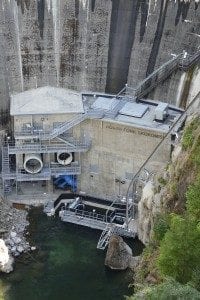North Fork Skokomish Powerhouse and Fish Facility
Summary

Tacoma Power combined a new, two-generator powerhouse with an innovative fish collection and transportation system. This new source of hydroelectric power on the North Fork Skokomish River in Mason County, Washington:
- Serves 1,700 Northwest homes
- Captures energy from previously untapped water flows
Working in partnership with the Skokomish Indian Tribe and natural resource agencies, Tacoma Power designed the unique system to use water discharged from turbines to attract migrating adult fish into a collector. The new fish collection and transportation facility re-opens fish passage on the North Fork Skokomish River, which has been blocked since the two Cushman dams were built in the late 1920s.
This $28 million project was supported by a $4.7 million American Recovery and Reinvestment Act award from the U.S. Department of Energy.
Background
The North Fork of the Skokomish River has long been a place of importance for the Skokomish Indian Tribe, known as “People of the River.” The river has provided many uses, including hydropower. Tacoma Power constructed the Cushman Hydroelectric Project, amid controversy, in 1929 to meet the growing electrical needs of the city of Tacoma, Washington. Cushman Dam No. 1 and Cushman Dam No. 2 now produce enough clean, renewable power each year to serve 27,000 Northwest homes.
In 2010, Tacoma Power received a new license for the Cushman Hydroelectric Project after one of the longest relicensing processes in history (32 years).
Challenge
The Skokomish Indian Tribe and natural resources agencies requested that the adult fish collection system be located at the base of Cushman Dam No. 2 to give migrating fish the maximum migration experience and spawning area. Tacoma Power wished to recover the energy from water released flowing into the North Fork Skokomish River at the base of the dam.
The utility tackled four challenges as it designed and built the North Fork Skokomish Powerhouse and Fish Facility.
- Use water discharged from the turbines to drive adult fish collection
- Design a method to move fish between the base and top of the dam
- Construct the powerhouse without dewatering the construction area
- Maximize available space at the base and top of the dam
Innovation
Tacoma Power designed the project using water discharged from the turbines to drive the fish collection system. The adult fish collection facility was built on a platform, picked up from four corners and lowered into place.
The fish tram transports adult fish to the top of the dam and juvenile fish to the base of the dam. It doubles as a material lift for moving tools and equipment used to maintain the powerhouse.
Tacoma Power developed innovative methods and used fish-friendly materials for the:
- Tram system to move adult and juvenile fish
- Fish handing and sorting facilities
- Sediment control dam used during construction
- Hydropower plant control system
Results
The North Fork Skokomish Powerhouse and Fish Facility:
- Provides clean, renewable energy for 1,700 Northwest homes (3.6 additional megawatts)
- Supports upstream and downstream fish passage for Coho, Spring Chinook, Steelhead and Sockeye salmon
The facility provides for the needs of both Tacoma Power ratepayers and the interests of the Skokomish Tribe Indian and natural resource agencies.
The successful completion of the North Fork Skokomish Powerhouse and Fish Facility is an outward sign that stakeholders of the Cushman Hydroelectric Project have strengthened their relationship and are working together to enhance the watershed.
Stakeholder quote
“The Skokomish Indian Tribe is pleased to work with City of Tacoma as partners in the Skokomish Watershed. Together we have worked long and hard to develop mutually beneficial hydroelectric power generation and natural resource management strategies. Key to these efforts are fish passage and fish supplementation facilities being developed by the City, in consultation with the Tribe and other Resource management agencies. These facilities, in conjunction with other terrestrial and aquatic habitat restoration and management efforts, are fundamental elements of a comprehensive fishery resource recovery effort in the Skokomish River.” – Joseph Pavel, Director, Skokomish Department of Natural Resources, Skokomish Indian Tribe


